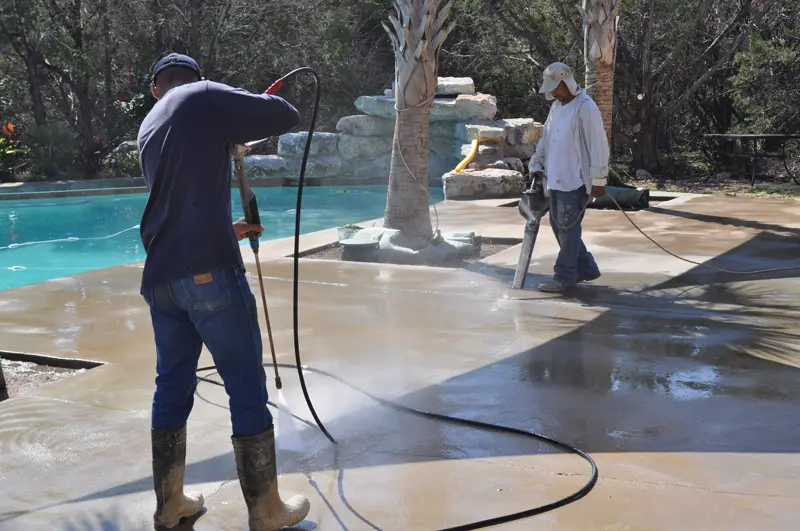
Acid washing vs Acid staining
First, let’s clarify something: acid washing concrete or cement is quite different than how to acid stain . Although these terms are often confused, they have two different uses and outcomes.
“Acid” when referring to concrete usually means muriatic acid or hydrochloric acid. This type of acid is used to etch or ‘burn’ into cement based surfaces. It can be used on its own or as part of a coloration system called acid stain.
Acid washing is the means of using acid to etch and prepare a cement surface for painting or the application of some type of coating. Acid is usually mixed with water and then applied to the surface of the concrete and scrubbed in. This will etch and roughen the surface so that a coating or topping will adhere to its surface. Generally this will leave no decorative color or finish behind. Acid washed or acid etched surfaces can leave some level of white staining or residue which can be very difficult to remove. It is important to work in small areas and not allow the etched residue to dry.
How to acid wash concrete
If acid etching, the area to be prepared is hosed thoroughly, being careful to wet down any adjoining areas that may be damaged by contact with the acid solution. It is very important to keep the entire area wet until completion of the etching process. Never allow the acid solution to dry on the concrete as this could weaken the adhesion of the system.
Etching is normally a two-man procedure, with one man operating the broom or floor machine (a nylogrit brush is used for etching) and the other man responsible for pouring the acid evenly and working the broom. The second man will also control the flushing of the area with the hose. The acid is mixed in a 5 gallon plastic pail – 3 or 4 parts water to 1 part acid. The strength of the solution is determined by the condition of the concrete. Very hard, smooth or shiny concrete will require a stronger solution.
The acid solution is poured into a sprinkling can and then onto the surface. Hold the sprinkling can close to the surface to avoid splashing the acid on adjoining areas. Caution: the acid solution will permanently damage aluminum doors or painted metal surfaces. Keep adjoining outdoor carpet wet at all times and minimize contact with the acid solution. Do not get acid on concrete areas not to be etched. If contact does occur, flush as soon as possible with water.
Five-gallons of mixed solution will cover approximately 150 sq. ft. The area will be scrubbed with the floor machine, systematically going first left to right, and then up and down. The second man will aggressively scrub the edges and places inaccessible to the floor machine. Use a stiff bristled broom or wire brush for this purpose. He will also work the hose to keep the area wet during the procedure.
Upon completion of a 150 sq. ft. area, rinse well. A properly etched concrete surface has the profile of 80-100 grit sandpaper. If the concrete still feels smooth, repeat the procedure.
After the concrete is thoroughly etched, pour 8 oz. APF Super Base Neutralizer into 4 gallons of water. Pour into the sprinkling can and disperse evenly over the area just etched. Scrub aggressively with the broom paying special attention to the edges and areas that may retain the acid solution (next to cabinets, washer and dryer, etc.). Rinse well.
If it is necessary to walk on an area that has been etched and neutralized, be sure to hose boots off to avoid recontaminating the area. If the etched area was a driveway or garage, be sure to flush the residue well down the street. This is done with one man working the hose and the other brooming the residue until it is
well dispersed.
